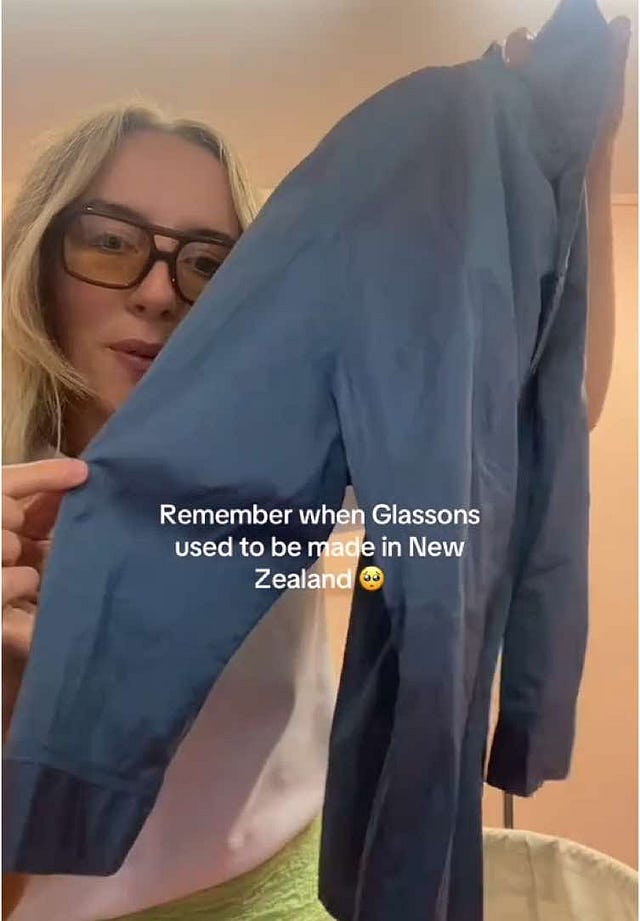Girl, the tariffs: The one where we unpack the trade war and what it means for small NZ brands
How the US tariffs could impact your wardrobe and bathroom shelf.
This is a guest post from Emma Gleason of the just-launched newsletter Crust. She’s previously worked for the NZ Herald, Viva and Fashion Quarterly, and was once a blogger known as Rag Pony. She’s also in a ‘fashion nerd’ group chat with Zoe.
How will Trump’s tariffs affect Aotearoa’s fashion and beauty industry, and how freaked out do we need to be? Emma Gleason asked economic experts and industry insiders to tell us how they feel.
We’ve seen the memes, and the headlines. We’re in the grips of a tariff war! Global markets are in meltdown! Trump targets island of penguins! We were warned not to check our KiwiSavers and it feels like everyone is suddenly expected to understand the complexities of international trade.
Elsewhere online, sentiment prevails that the 1980s are back, “boom boom”. Tariffs were making headlines then too but for very different reasons; around the world they were being scaled back in the name of the free trade and market globalisation that would define the neoliberal era.
In New Zealand it was called Rogernomics, and it hit the tariff-protected fashion industry hard. Designers competed with fancy imports, while domestic factories lost out as many homegrown brands moved their production offshore where it was cheaper. (Fun fact: Even Glassons used to make their stuff here).
Fast forward to 2025 and New Zealand’s fashion landscape is vastly changed, with businesses facing competition from online retailers of all stripes like Temu, Ssense and The Real Real. Local manufacturing is shrinking. Some labels still produce on-shore, while others go to Asia and Europe. Kiwi brands have direct access to shoppers around the world, and it’s never been easier (or more competitive).
The industry is steeped in anxiety already, so waking up to a flurry of headlines about Trump’s tariffs would have brought many out in a cold sweat. Firstly, it was confusing, then it was clarified New Zealand was facing a 10% base tariff rate — not 20% after all — making us relatively lucky compared to countries like Thailand and Bangladesh (37%), Vietnam (46%) and Cambodia (49%).
The ensuing share market tumble was compared to the pandemic and 1987 crash — are the 1980s back? — then China and the US started volleying additional tariffs, 34% and 125% respectively (as I write this).
It’s enough to make even the most stoic of us spiral. I saw so many friends take to social media to share stress, information and (of course) memes.
Baina co-founder Bailey Meredith, feeling uneasy, turned to Instagram, curious if her peers had similar concerns. The responses “clearly highlighted that many of us are in the same situation”. She feels concerned it may signal widespread disruption and negative consequences, but also has sense of urgency to “act proactively and prepare for the inevitable changes”.
She and Anna Fahey launched the towel and bathware brand in 2019, and the US has become a key market for Baina, accounting for 30% of its global business. “As our towels are made in Portugal, we will be subjected to a 20% tariff. These tariffs are imposed at the port of entry, meaning we, as the importer of record, will bear the additional costs, which will inevitably impact our profit margins.”
Staying level-headed can help you cope. “In moments like these, it’s crucial to remain measured and well-informed, while also maintaining the flexibility to adapt as circumstances evolve,” Bailey says. “We’ve held team discussions focused on scenario planning, but for now, our approach is to stay vigilant and informed, observing how the situation unfolds. We are prepared to pivot as needed, but for the time being, our strategy is one of careful observation.”
Others are in a similar position, manufacturing offshore for myriad reasons (cost, volume, technical expertise, market proximity). Local makers are also worried, wondering whether the price for imported components like fabrics and zips will go up, eating into already tight margins.
For Juliette Hogan, exports are not particularly global but the brand’s supply chain is. “As one of the key suppliers of our raw materials and knitwear, the impacts on the Chinese economy will no doubt have a significant trickle-down effect on us here,” Juliette explains, and says it’s hard making clothes here and running a sustainable, healthy business.
“Every margin point matters so am sure you can understand that the confusion at the moment is unsettling for both us, the wider industry and many businesses.”
Mindful Fashion NZ chief executive Jacinta FitzGerald said the industry body was “working to support members by circulating up to date information as it becomes available on the implications of recent tariff changes, and the impact on global supply chains and export to the US”.
Rachel Mills produces her namesake brand domestically and 80% of their sales are from within New Zealand. She wonders if there’s opportunity in the US.
“As we manufacture locally, we are at much less of a disadvantage against both New Zealand and US brands that produce in China, which is a huge portion of the industry,” says Rachel. “As much as I hate to say it for obvious political reasons, does this mean it is a good time for us to be considering the US market?”
She also runs RM Sampling House (formerly The Pattern Table) which does garment sampling and production. “We have been gearing up over the last few years thinking that there isn’t a whole lot of hope that production of brands locally will increase.”
The introduction of tariffs have added considerable uncertainty to the manufacturing side of the business, and they’re looking at areas to refocus on. “A lot of our current clients do produce in China, while we focus on only the sampling portion of these offshore garments. It will be interesting to see what flow-on effect it does have for our client work,” says Rachel.
”If brands were to pivot immediately to local production, many factories here won’t yet have the infrastructure to service them quickly. So many factories have closed down or downsized in the past few years.”
Some people, like Auckland University professor of entrepreneurship Rod McNaughton, wonder if Trump's tariffs highlight the need for us to be making more things here in New Zealand.
It’s not an option for businesses like Baina. “We rely on Portugal, where we can access the necessary expertise and facilities to meet our quality standards at a competitive price,” explains Bailey, and onshoring is unfeasible. “Unfortunately, New Zealand lacks the infrastructure and factories required to produce high-quality, GOTS-certified towelling at scale. The specialised manufacturing processes involved in creating the kind of premium towels we offer simply aren't available here.”
Is this a wakeup call for reshoring? Economist Shamubeel Eaqub thinks it’s going to be really hard to put that genie back in the bottle. “The reality is that the production of goods and services has become so complex, spread across countries and value chains.”
Global trade, low tariffs and digital innovation mean it’s now the norm for brands to sell directly to overseas customers via their own ecommerce channels. Many have also worked hard to establish stores and stockists in the American market; Yu Mei is sold at Bergdorf Goodman, Karen Walker counts Bloomingdales among dozens of American stockists, All Birds has 25 retailers and Icebreaker runs two “touch labs”.
The ability to sell offshore can supplement the comparatively tiny pool of domestic customers. A 2024 industry report by Mindful Fashion put the number of finished goods from New Zealand-based businesses sold overseas at 18%. The US alone has 340 million people, we have 5.2 million — you do the math.
Shamubeel predicts things are “really going to heat up” between manufacturing nations. With such massive tariffs put on garment producers like China, Vietnam and Bangladesh, global manufacturers will be looking for alternative markets to the US.
This creates “a real risk that we’re going to see a significant oversupply of products, at least for a short period of time, which might create a huge amount of competition for our local manufacturers, producers and sellers,” Shamubeel explains. Retailers who sell imported products might see costs go down, and we may (at least for a while) see lower prices
“We benefit as much from imports as we benefit from exports. But we shouldn’t lose sight of the fact that imports have given us access to good and services and prices that were unimaginable 20 years ago,” Shamubeel says. “Given what’s going on in the world, it’s pretty clear that there’s a rise of nationalism… and we have to ask ourselves, what does it look like in New Zealand when we do things?”
For small business owners who are (understandably) freaked out, he says there are three important questions to ask yourself.
What’s happening out there?
“Just really understanding what is a tariff, and what does it do to what they do,” says Shamubeel. “Whether they’re an exporter or importer, what are the channels of impact for their business.”
Given what’s happening around the world, what is the effect on my business?
Half is awareness, and half is how that translates to your work. “Will your suppliers be affected by the tariffs on the US? Will you be caught up in the tariff warfare between China and the USA? Those are really important questions, and they’re very different for each business.”
Given what I know, what can I do, and what levers of control do I have in my business to be able to do that?
Focus on your customer, and your employees “Make sure that your products and services are really meeting the needs of your customers in these uncertain economic times,” Shamubeel explains. “Make sure that your team is ready to respond to this uncertain environment. That means good leadership, good management decisions, and good culture in your organisation.”
Baina’s Bailey is big on community during periods like this. “In times of uncertainty, collaboration is key, and I believe it’s vital to come together, share insights, and keep each other informed, ensuring we are as equipped as possible to adapt to the challenges ahead and gain as much understanding as possible about how we, as a business, would navigate this evolving landscape.”
And, of course, there’s the vibes of it all (cue an avalanche of recession indicator memes). How we feel impacts what we spend. When every purchase feels loaded with impact, Shamubeel advises consuming in a deliberate fashion.
“Can you support your local community shops and local community people?”
Still stressed and doomscrolling? “Watch less news,” Shamubeel advises. Be aware, but don’t get too caught up in what’s happening around the world.
“When there’s so much change all at the same time it can feel really, really difficult to deal with.” He likens it all to drinking from a fire hydrant. It’s not going to stop, so step away from it.
“It can feel very paralysing when you see the world just not making sense, and it can become very easy to become glued to the news and the headlines, rather than doing all the other things that can make you happy,” he says. “Fundamentally, if I think about it, what’s the point of it all? It’s family and community. Are those things gone just because there’s a tariff war going on?”















